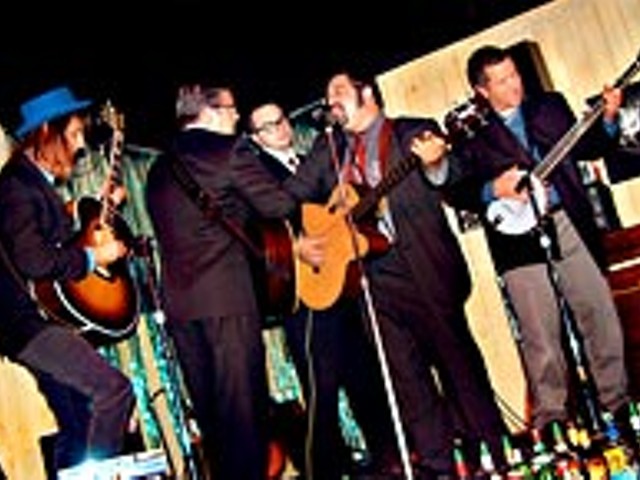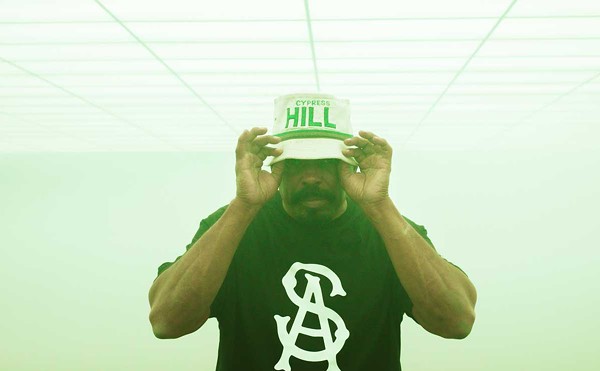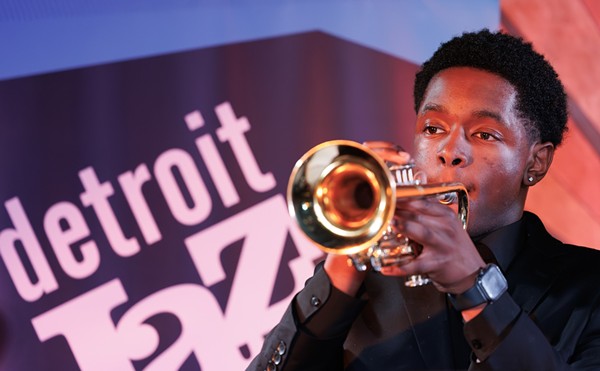Stop what you’re doing for a second, close your eyes and ask yourself: What the hell is techno?
Keep ’em closed, smart guy.
OK, so what popped up on the plasma screen of your mind? A glitzy club with high ‘NRG’ dance music, complete with sirens, glittery tube-toppers, heavily scented velvet ropers and lots of confetti (for no apparent reason)? The furry hat girl from that Mitsubishi commercial? Maybe you saw a small flock of brightly colored youths wearing teepees for pants. Perhaps you pictured lofts, or rotting buildings being turned into makeshift dance halls. Was it all just drugs, drugs, and more drugs? A (gulp) Ford Focus, maybe?
Most have the wrong idea about techno music and its surrounding culture. If anything, this misunderstanding should be considered a testament to the fact that the word “techno” has permeated the world’s collective subconscious and we have Detroit artists to thank for that. The Detroit Electronic Music Festival raised local awareness of techno, but the public’s understanding of this music seems more questionable and confused than ever. There’s no end-all definition of techno, but Jeff Mills, “The Wizard” (as he was once known on local radio) of Detroit techno’s Oz, comes pretty close with this blanket definition: “It’s the process of trying to describe something in the future (musically). To make it simpler, it means dreaming, fantasizing.”
But techno wasn’t invented in Detroit; it was innovated in Detroit.
“Techno from as early as Kraftwerk until now is all the same — it has not changed,” Mills says. “It went through metamorphosis, it redeveloped itself, but the main vision that people have had has stayed the same. There’s no right or wrong way to make techno. You don’t have to use a particular keyboard. It’s basically anything that anyone can dream of. Anything can change depending upon technology. The myth that techno should be 130 (beats per minute), and that the kick should be 4/4 is a misconception.”
According to Mills, techno is more of an idea than it is a specific sound. The word, in his mind, refers to forward-thinking art in general and can be used to describe anything from Picasso to George Clinton. But if techno should be defined so broadly, what makes Detroit techno so inimitable?
“Musicians in Detroit are very tough and resilient,” asserts Mills. “That’s a known fact. You can hear their integrity in the music. The city is not like LA. It’s not a fabricated place — it’s very true. I think you can hear that in the music. The sounds are very pure, not synthetic, fabricated sounds, whether it be techno or any other type of music from Detroit.”
Detroit techno’s dark edge turned pre-laptop machine guts inside out rather than treating these tools like knockoffs of acoustic instruments. Others had done something similar, but the early Detroit artists did it with a soul that screamed regional identity. In the ’80s, Detroit got its post-Motown groove back and it was an unearthly mutation. The post-disco-meets Chicago house-meets-Kraftwerk sound was pitch-black compared to Motown, but twice as uplifting at high decibels.
Techno is something to be experienced rather than simply heard, which may come as a surprise to some. And lack of any significant radio support means that it usually takes a turntable shaman like Mills to give you chills. Misunderstanding, therefore, abounds.
“As much as I travel all over the world,” says Mills, “there’s no place where there’s such a concentration of people making such a similar sound of techno music. Maybe it’s the mood that it projects. There’s nothing that’s similar to what’s happening in Detroit — and it’s been happening for over the past 15 years. The perspective that most Americans have about techno is just partial. They only see a very small part of what it has done and what it can do.”
That’s just what the Detroit Historical Society hopes to remedy with its new exhibit “Techno: Detroit’s Gift to the World,” at the Detroit Historical Museum, 5401 Woodward, Detroit. By showcasing the lives and work of the people who made Detroit techno a worldwide phenomenon, the exhibit aims to put what has primarily been an oral history into a multimedia display. The exhibit opens Jan. 18.
“When you travel to other countries, it’s probably the most respected form of electronic music that we have today,” continues Mills. “Perhaps this exhibit can explain this a little more to the people of Detroit”
“I hope that we inspire people,” says exhibit coordinator Sulaiman Mausi, “more specifically the youth of Detroit. We want kids to say, ‘If he can do it, I can do it.’ Another thing that’s important to capture is their entrepreneurial spirit. When Juan [Atkins] couldn’t find anyone to put out his records, he did it himself. It’s about the music, but it’s also about the accomplishment of creating something that was not there.”
Putting Detroit techno’s convoluted past into a neat context isn’t an enviable task for any historian. For years, Detroit techno fans and critics have been rehashing the story of how Juan Atkins, Derrick May and Kevin Saunderson — or the “Belleville Three” as they’re often called — turned Detroit into the epicenter of future funk. Certainly, there were other musicians, DJs, and even promoters who made techno happen, but this exhibit marks the first time that Eddie Fowlkes has been publicly dropped at the top of the mix. The Detroit Historical Society has billed the techno exhibit as “… the straight story of how Juan Atkins, Eddie Fowlkes, Derrick May and Kevin Saunderson, four young men from metro Detroit, created and developed this electronic style of dance music.” Fowlkes was one of techno’s seminal producers and one of its hottest DJs at the time, but there’s no doubt that this promotion will remain a sticking point for many techno snobs. Compared to the sheer number of artists and fans that any of the Belleville Three inspired, Fowlkes looks like a fifth Beatle.
Still, as many problems exist when dividing Detroit techno by three as when dividing it by four. It should also be noted that it was techno’s Belleville Three who insisted the pedestal be shared with Fowlkes for the exhibit.
“I can think of a few people who played a more influential role than Eddie [Fowlkes],” says Mills, “but he was one of the original people. Blake Baxter played a very important role in Europe at the early stage. But I’m sure that the organizers of the exhibit will give enough attention to each person and their contributions. There are at least 30 people who were influential in getting techno to this particular phase.”
Mausi explains that the DHS wants to show more inclusion than has been displayed in past interpretations of techno and there wasn’t enough information on exactly where to draw the line. They also couldn’t contact every artist beforehand. Besides, the flawed logic behind rating and quantifying musicians isn’t particularly worth dwelling on — which is probably why the exhibit is focusing on dozens of individuals and labels as equal pieces of the puzzle.
For once, techno’s history will be open to the public for debate. Excavating a subculture that prides itself on its underground, exclusionary nature is bound to yield a disparate range of opinions. So far, the American music press has done more to water down the music and lighten the average skin tone of its producers than it has to explain it to potential fans. It’s no wonder then that techno often gets lumped with garbage from the mainstream. It’s also no secret that America is image-obsessed — something that most Detroit techno artists frown upon (outwardly, anyway). It’s hard to put a face on dance-oriented, mostly instrumental music in this country.
“It’s not like that in Europe and elsewhere,” says Mills. “It’s the music first, then they appreciate the person who made it after. In America, it’s the person first, then the music. I DJ between 160–180 parties a year. I’m exposed to millions of people per year outside of this country. It’s an amazing situation, but America just doesn’t seem interested.”
As with most American music styles, it’s almost always the case of “we don’t know what we’ve got till it’s hit overseas.” But with kids doing hands-on learning like tracking simple techno tunes in our museums, maybe tomorrow’s techno stalwarts won’t feel like they are working in a vacuum.
The Detroit Historical Museum’s “Techno: Detroit’s Gift to the World” will kick off with Ignition 2003 at the Roostertail (100 Marquette Drive, Detroit) on Friday, Jan. 17. Scheduled to appear are Juan Atkins, Derrick May, Eddie Fowlkes, Jeff Mills, Electrifying Mojo, Blake Baxter, K-Hand, Mr. Dé, Keith Tucker, Alan Oldham, Octave One and Mike Huckaby. For information, go to detroithistorical.org.
Robert Gorell gets electronic for Metro Times. E-mail him at [email protected]




